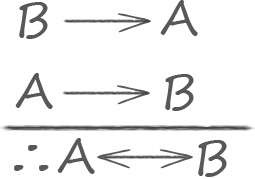Notification
You need to select an answer first.

A byconditional (called also an equivalence) is a sentence of the form
A if and only if B
or in symbols:
A ↔ B
A byconditional is true just in case the two clauses are of the same truth value (i.e. either both true or both false).
A byconditional is equivalent to a conjunction of two conditionals of this form:
A ↔ B is equivalent to (A → B) and (B → A)
Where does the expression “if and only if” come from?
Remember that “A, only if B” is symbolized as A → B. “A, if B” is symbolized as B → A. Taken together, i.e. in a conjunction, they give us “A if and only if B”.
Since we know that A ↔ B is equivalent to (A → B) and (B → A), and we know that (A → B) and (B → A) is equivalent to (~B → ~A) and (~A → ~B) (we just replace each conditional by its contrapositive), we can infer that
A ↔ B is equivalent to ~A ↔ ~B

Prof. Bazett of the University of Cincinnati introduces you to biconditionals in the following video (bi-conditionals combine two conditionals):
This video is purpose-built for the LSAT and expands into combining biconditionals and contrapositives.
Next LSAT: Sep 08/ Sep 09

We know that by claiming a byconditional:
A ↔ B
we claim that the two clauses A and B have the same truth value (i.e. they are either both true or both false).
How do we say that some two clauses A and B have the opposite truth value?
In one of these ways (it is not important which one, because they are all equivalent):
~A ↔ B
A ↔ ~B
B ↔ ~A
~B ↔ A

The company gains profit if and only if it earns more than it spends. The company does not earn more than it spends.
If the above statements are true, which one of the following must also be true?
(A) If the company does not earn more than it spends, then it does not gain profit.
(B) The company does not gain profit.
(A) If the company does not earn more than it spends, then it does not gain profit.
&
(B) The company does not gain profit.
|
Statement |
Symbols |
Valid/Invalid |
Description |
| 1. If the company gains profit, then it earns more than it spends. |
company profit → earn more |
Given |
Premise 1 |
| 2. If the company earns more than it spends, then it gains profit. |
earn more → company profit |
Given |
Premise 2 |
| 3. If the company does not earn more than it spends, then it does not gain profit. |
~earn more → ~company profit |
Valid |
Contrapositive of premise 1 |
| 4. If the company does not gain profit, then it does not earn more than it spends. |
~company profit → ~earn more |
Valid |
Contrapositive of premise 2 |
Premise 1:
If the machine works (MW), then the parts are installed correctly (IC).
MW → IC
Premise 2:
If the parts are installed correctly (IC), then the machine will work (MW).
IC → MW
Biconditional:
The machine will work if and only if the parts are installed correctly.
MW ↔ IC
Premise 1:
If I graduated with honors (GH), then I got a grade of 95% or higher (95).
GH → 95
Premise 2:
If I got a grade of 95% or higher (95), then I will graduate with honors (GH).
95 → GH
Biconditional:
I will graduate with honors if and only if I get a grade of 95% or higher.
GH ↔ 95
Premise 1:
If she attended the birthday party (BP), then she finished all her tasks for that day (FT).
BP → FT
Premise 2:
If she finished all her tasks for that day (FT), then she will attend the birthday party (BP).
FT → BP
Biconditional:
She will attend the birthday party if and only if she finishes all her tasks for that day.
BP ↔ FT
Click the start button to line up the game in your browser.
(Note: game is down for a few days).
This is an adaptive drill: The questions will get harder or easier depending on your performance. You can't go backwards or change prior answers.
Complete: 0 / 3 correct
Moving on to the next lesson: Conditional Conjunctions